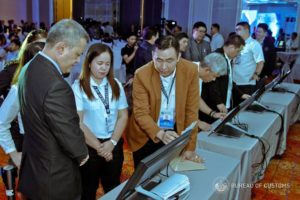
The Bureau of Customs (BOC) and the House of Representatives (HOR) Committee on Ways and Means are creating a technical working group (TWG) to discuss concerns with the customs bureau’s National Value Verification System (NVVS).
“We sought approval of the committee on Ways and Means for a creation of Technical Working Group so we can work with them in resolving the issues of the NVVS. It will be discussed in the TWG if NVVS will be suspended while its issues [are] being reviewed,” BOC assistant commissioner and spokesperson Atty. Vincent Philip Maronilla told PortCalls in text messages.
Maronilla said the TWG will be composed of members of the Committee on Ways and Means and BOC officials.
The HOR Ways and Means Committee has held several hearings on the NVVS in the wake of complaints and concerns from stakeholders since it was implemented in the second half of last year.
In a hearing last December, the Lower House Committee on Ways and Means even motioned for BOC to suspend the system amid issues raised by stakeholders and the possibility it may violate the World Trade Organization’s (WTO) methods of valuation.
BOC last year also started a review of the system as requested by the same committee. Results of the review will be discussed during the TWG meeting, Maronilla noted.
Asked if the system would be suspended while the TWG review is ongoing, Maronilla said BOC has requested “continued implementation of NVVS functionalities which the committee finds acceptable.”
On whether compliance with the system has seen improvements, Maronilla said that according to BOC’s Import Assessment Service (IAS), “stakeholders are well informed and that they are constantly addressing their concerns.”
The NVVS is the agency’s internal system that customs assessment officers may access to verify whether the value declared by the importer is the price actually paid or payable for the goods when sold for export to the Philippines.
Earlier this month, Maronilla, in a forum with stakeholders, said BOC will continue to implement the NVVS as one of its trade facilitation measures this year.
IAS director Atty. Yasser Ismail Abbas told PortCalls BOC is also working on enhancing the NVVS by improving the data collected by the agency’s Electronic-to-Mobile (E2M) system.
READ: Improved version of NVVS for adoption this year
Abbas said BOC plans to improve the system this year by allowing other units of measurement besides kilograms (kg) to be used in establishing the volume of different types of commodities and shipments in the E2M—its other system where stakeholders lodge and declare their shipments. By doing this, he said, the reference values in the NVVS can be improved.
Abbas explained the NVVS is “actually entirely dependent on the E2M system” and its data.
Value verification in the NVVS is based on the previous importation, on similar and identical goods at the same period of importation, and on other methods of valuation available under Republic Act No. 10863, otherwise known as the Customs Modernization and Tariff Act (CMTA).
Abbas said that if data in the E2M are improved and have proper and specific descriptions, “then we will be able to value the commodities better and in turn it will be reflected sa NVVS.”
For starters, BOC already issued in November last year Customs Memorandum Order (CMO) No. 49-2019, which requires declarants to accomplish completely and properly the supplemental units under Box No. 41 of the goods declaration in the E2M system.
For tariff headings under Annex A of CMO 49-2019, the E2M “will automatically reflect the unit of measurement as pieces…”
He noted, however, that compliance with CMO 49-2019 is still low, but once compliance goes up and data are sufficient, the change in unit of measurement can be “reflected” in the NVVS.
Abbas said CMO 49-2019 is just the first phase as BOC also intends to incorporate other units of measurement first in the E2M and eventually in the NVVS.
He added that IAS has been “going around collection districts” to talk about the NVVS, while trainings of appraisers on how to do proper description continue.
He again clarified that the transaction value system has not been discarded when the NVVS was implemented, and that customs appraisers should still implement the methods of valuation under the CMTA.
Abbas said the NVVS is an “enforcement risk management tool to tell the assessment personnel that there might be a problem in the customs declaration.”
He noted, however, some appraisers, in their “zealousness” to collect targets, “diregard documents presented by importers, then automatically upgrade [value],” which shouldn’t be the case.
Abbas said the rule is to apply the first method (transaction value) and if the importer is unable to “substantiate” his declared value, then other valuation methods should be followed.
The Chamber of Customs Brokers, Inc. (CCBI), in a complaint letter to Customs Commissioner Rey Leonardo Guerrero dated November 12, 2019, cited instances of “non-acceptance of the proof of payment as evidence for shipments with higher NVVS compared to the declared value.”
“There are many instances wherein shipments have been upgraded to match the NVVS value despite the submission of complete documents with proof of payments,” CCBI claimed.
The BOC Employees Association, in a statement, said they “strongly reject” the implementation of NVVS, claiming it was anti-trade facilitation as it “forces” customs officers to “adopt a valuation that is based on a database of previously utilized values with a per-kilogram unit value.” – Roumina Pablo
Photo from BOC





